Future-Proofing Your Project: Guide to Custom Software Development Costs in 2024
- What is software project cost estimation?
- Why shouldn’t you skip software project cost estimation?
- How much does custom software development cost?
- What are the top factors that influence software project cost estimation?
- Which Software Development Hiring Model is the Best?
- How fancy is your UX/UI design?
Something that worries businesses the most when planning to build custom software — is the cost.
Adaptability and future-proof market survival are outcomes of successful custom-built software. But the prize to ultimate success is huge.
Custom software development isn’t a cheap investment.
Roughly, these are the cost estimates for different software development projects:
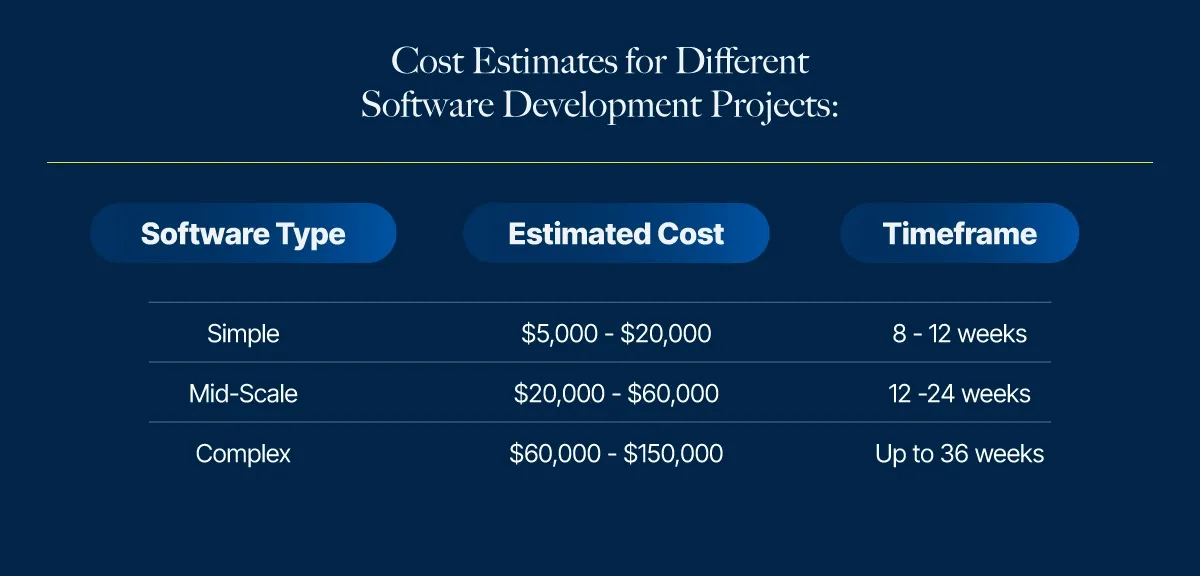
Even the simplest project can demand around $5,000. In case you’re planning to build a cross-platform, your budget can easily grow to multi-thousand or multi-million dollars.
These prices are however indefinite. Several factors influence software product costs, including resources, project complexity, size, technology, etc.
Once Benjamin Franklin said, “If you fail to plan, you’re planning to fail” — nothing can be more accurate about the software project cost estimation processes.
Knowing the factors, tips, and tricks can help you control your budget and make well-thought-out decisions for your next development project. Let’s get into details:
What is software project cost estimation?
Software cost estimation analyzes and predicts the resources and effort required to develop a software system. For example, COCOMO (Constructive Cost Model) is one commonly used model that estimates software development effort based on lines of code.
Function point analysis is another example that helps quantify the functionality provided to the user based on inputs, outputs, queries, and interfaces.
Software development cost estimation is pivotal for forecasting project time, effort, scope, and overall success rate before the planning stage.
Cost estimation provides a ballpark figure and not the final costs.
Accurate cost estimates require information on a company's experience, tech stack, development life cycle, available resources, duration, and third-party services.
For example, an estimate for building an e-commerce website may include costs for web hosting, payment gateway integration, and security services.
Therefore, predicting the time and effort is necessary to ensure error-free product development and mitigate technical and financial risks.
Why shouldn’t you skip software project cost estimation?
Cost accuracy is paramount for clients to confidently fund their projects before making commitments. Poor estimates can lead to
- Budget overruns (according to Forbes, an average software development project overruns the budget by 27%. Moreover, one in six tech projects can go 200% beyond budget and 70% beyond schedule.)
- Rushed development to meet unrealistic budgets
- Fund depletion
- Demoralized teams due to unmet expectations.
Aim for a 5-10% error margin to reduce these risks.
But you should always ensure that the more accurate the software project cost estimations, the better the chances of successfully finishing the project.
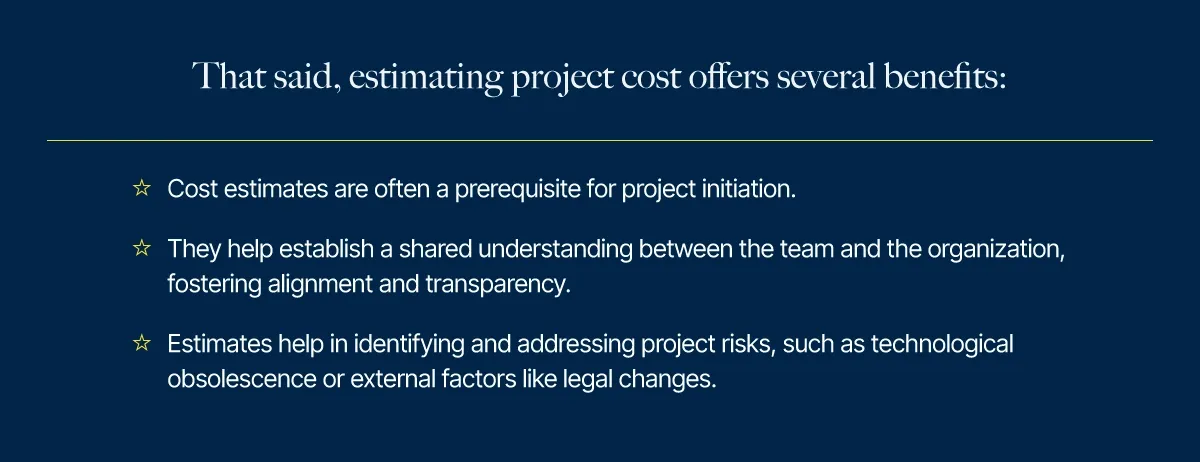
How much does custom software development cost?
Custom software development costs typically between $40,000 and $160,000. However, this estimate provides only a rough cost estimate. Several factors influence the actual cost, including:
- Solution complexity
- App type
- Development team
- Team location
Average software development cost
Different industries have varying cost ranges for custom software development. Below is a basic idea of custom software development pricing in the renowned industries:
- Healthcare: $75,000 to $250,000+
- Logistics: $50,000 to $250,000+
- FinTech: $90,000 to $300,000+
Below are app types and their estimated costs:
Can you calculate the cost of developing a software product?
Unfortunately, it’s not easy to estimate correct costs. There are several inputs for finding a close project cost estimate.
What do you need to estimate a software project?
Here is a list of inputs that you will need to create a workable cost estimate:
By incorporating these inputs into the cost estimation process, teams can enhance accuracy and better navigate project complexities. But there is more than meets the eye.
Let’s dissect the major factors that impact software product development costs.
What are the top factors that influence software project cost estimation?
Custom software development comes with factors that impact the project cost and timeline. Each element holds value and may cause severe implications if overlooked.
Therefore, to carefully perform software development cost estimation, consider these factors:
Project scope and target platforms
Full-stack product development is a broad-spectrum project divided into smaller details ranging from sophisticated platforms to simple landing pages, each tailored to meet specific business goals and requirements.
Here are some common types of software development projects:
- Building a product from scratch
- Modernizing a legacy system
- Adding bespoke software features/integrations to an existing solution
- Designing a web application
- Building a mobile app, and more.
Choosing and adapting according to your target platform significantly impacts development costs and takes extra effort.
Common platforms to deploy custom software include:
- Windows
- Android
- Mac
- iOS
- Linux
- Unix
- Web
Different platforms demand a different cost structure as depicted in the infographic below:
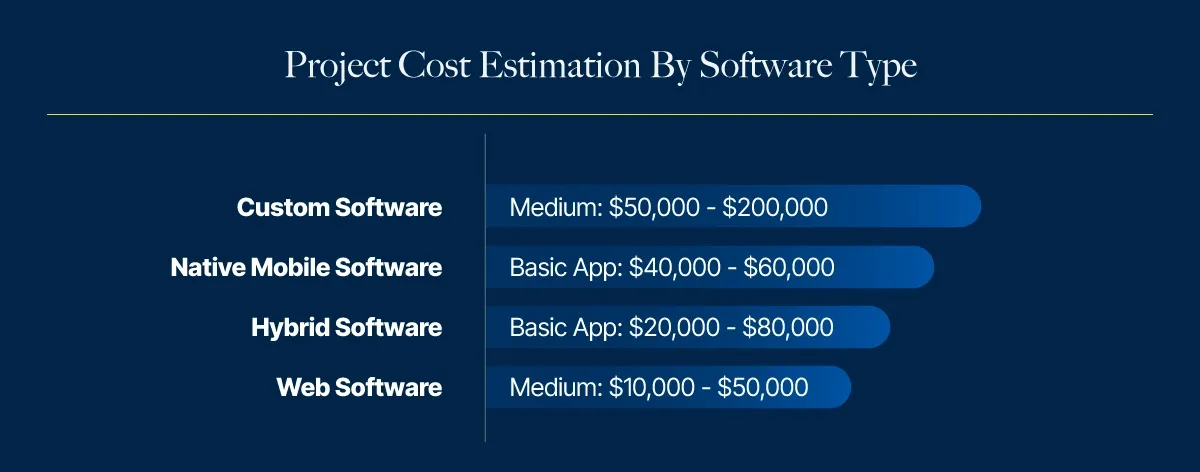
For example, in native app development, you must develop and maintain separate codebases for iOS and Android, which makes hiring expert developers and doubling payroll costs necessary. In contrast, cross-platform development involves writing code once and deploying it across multiple platforms, offering time and cost efficiencies.
Additionally, there are several development cost variations between iOS and Android platforms. In North America, for instance, Android development is pricier than iOS development, except in Eastern Europe, where the difference is minimal.
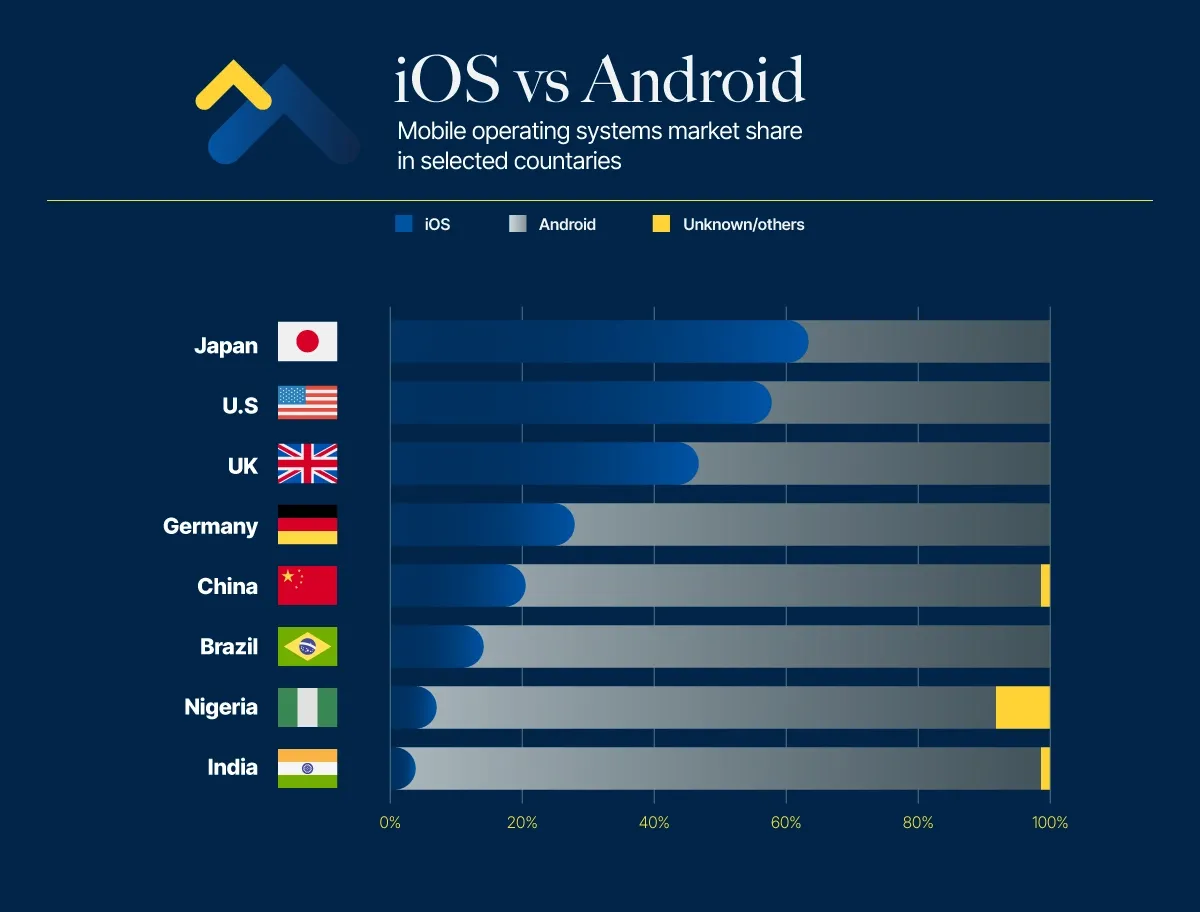
This discrepancy is primarily due to complexities in the Android system such as varying specifications, operating systems, and screen sizes requiring rigorous app testing on multiple devices and platforms to ensure it performs well for users.
But also get ready to invest significant time and manpower. Otherwise, think of a workaround.
In contrast, iOS development is more streamlined. You can manage variations among devices and programming in the backend and ensure simpler and easier development.
Many developers prefer iOS programming languages like Swift to their Android counterparts, such as Java and Kotlin for convenience, reduced development costs, and shorter timelines.
Since we are talking about programming languages, let’s have a quick look at their costs too:
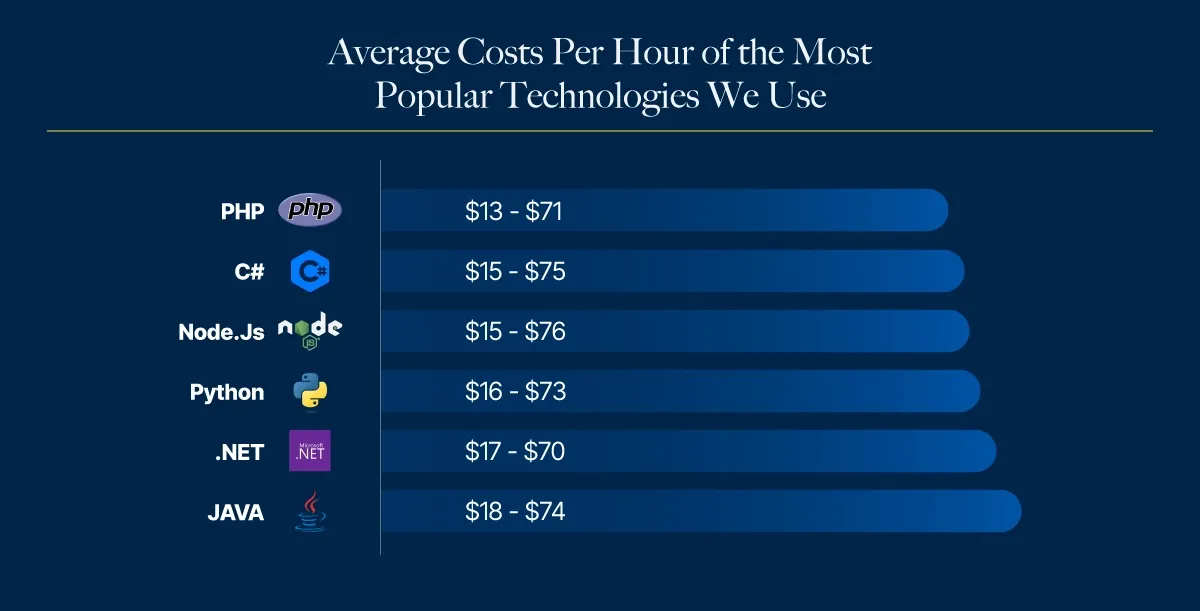
Tip time :bulb:
Cross-platform app development can save big on development costs. While it's efficient for simple projects, complex platforms like fintech or streaming may not benefit financially due to specialized requirements.
Software complexity is the game changer
Let's break down how complexity affects the cost of developing software.

The software app development costs depend on several moving parts including the expertise of the developers, user roles, functional components, external APIs, and how data flows between your server and the software itself.

And with time the expenses pile up with ongoing research, marketing, and maintenance — often totaling millions of dollars.
Now, why does this matter? Well, the more complex your software, the longer it takes to build. The more developers you need, the more effort to retain, manage, and communicate.
Because let's face it—app complexity is the big kahuna when it comes to driving up development costs.
Take, for instance, two different types of software: an app like Grammarly, the grammar-checking wizard, and a basic CRM system. Building software like Grammarly with intricate algorithms and server interactions can demand $300,000. On the contrary, a simple CRM development may cost around $35,000 only.
But even small projects can pack a punch.

Imagine you're building an app, each feature you add means more time, effort, and manpower. The software complexity defines how many modules, screens, and features need development.
For example, a basic login screen may cost you around $100. But adding advanced features like two-factor authentication or encryption can amp up your bill to $10,000.
And should we get started on e-commerce features? Adding those could shoot your budget anywhere between $2,000 - $25,000.
Now, let's talk tech.
Want to use AI, AR, or blockchain? Cutting-edge but these super technologies come with a price tag.
Bespoke AI or AR solutions can be expensive, ranging from $6,000 to $300,000 due to their complex features and customization options.
Besides, developing a basic blockchain app costs around $10,000, while a sophisticated DeFi app can cost you hundreds of thousands or even millions.
So software development complexity is the name of the game.
The more intricate your software, the higher the costs—and the greater the potential for innovation and success.
Dream Team comes with a price tag
Your development team is the cornerstone in shaping your project's costs. Let's discuss team factors that can affect your project costs.
Costs defined by team size
Your core software development team typically includes:
- Project manager
- Software architect
- Software developers
- UI/UX designers
- QA specialists
- Business analyst
One resource may cover multiple roles in smaller and fast-paced projects. However, a dedicated team member manages particular tasks in large projects.
Here's a breakdown of team sizes based on project complexity:
Cost based on team type
Here's a comparison based on different team types for a project of average complexity:
You can mix senior roles with middle or junior developers to better manage costs. And remember, the size of your team impacts your expenses — the larger the team, the more developers you need to pay.
According to SmartBear's survey, the sweet spot for team size is around 6–10 members for an app of average complexity.
Costs based on location
Here’s a quick region-based comparison of software development costs based on developer seniority level across regions:
Location is another pressing point when outsourcing your software project. You may encounter the following challenges while doing so:
Living costs and wage differences
Regions like the US or Western Europe often have higher living costs, leading to higher wage expectations for developers. As a result, software development costs are higher in these areas.
Talent pools and expertise
Regions with a larger pool of skilled developers may offer more competitive rates due to increased market saturation. On the contrary, regions with scarce talent may demand higher fees swelling up your costs.
Communication and collaboration barriers
Time zone differences and language barriers can impede effective communication and collaboration between teams, leading to inefficiencies and potential delays in project completion.
These challenges may necessitate additional resources or tools to mitigate budget overruns and other financial risks.
Cooperation Models for Your Software Development Partner
If you are hiring developer(s), consider these options to explore various levels of flexibility and predictability.
- Fixed-rate/ Time- and-material
- Hourly rate
- Dedicated team
Let’s get into details:
Which Software Development Hiring Model is the Best?
Compare and decide better:
Fixed Rate Model
- Pros: Suitable for clear project requirements; you know the exact cost upfront.
- Cons: Less adaptable to changes in scope or emerging requirements.
Hourly Rate Model
- Pros: Offers flexibility and adaptation to changing requirements.
- Cons: Overall cost may be higher than initial estimates; requires monitoring of development hours.
Dedicated Team Model
- Pros: Ideal for long-term projects with changing requirements; provides flexibility and cost predictability.
- Cons: Generally higher overall costs due to team exclusivity and commitment.
Although every option above has its pros and cons, an ideal choice, especially for startups in high-income nations, is opting for an offshore software development agency.
Thus, agree upon a well-laid-out communication model and opt for a vendor with a track record of delivering completed projects.
Just a hint :bar_chart:
70% of companies choose to outsource app development for cost reduction.
Deloitte
How fancy is your UX/UI design?
UX/UI design is a conscious effort to create visually appealing and user-friendly app interfaces. It's not just about making pretty outlooks; it's about ensuring effortless task performance completion for the users.
This level of finesse demands considerable expertise from developers, and naturally, it comes at a cost.
UI design complexity significantly affects development costs.
A minimalistic design with standard elements and basic layouts is more cost-effective than creating custom and detailed UI graphics and animations.
These demand more time, creativity, and technical skill — synonymous with higher development costs.
UX complexity comes with costs…
UX design focuses on enhancing users' overall app experience through research, testing, and iterative improvement based on feedback.
However, detailed user personas, mapping user journeys, and prototyping are all time-consuming tasks that drive up development costs.
The more tailored and interactive the UX, the bigger the investment required.
App responsiveness and adaptability are important but costly.
Designing for multiple platforms and ensuring adaptability across various screen sizes and devices increases development costs. Therefore, planning and testing designs are important for reliability, adaptability, and responsiveness across different platforms.
Each adaptation and improvement adds to the overall cost.
Tip time :bulb:
It’s smart to start with a minimalistic yet user-friendly UX design for your MVP. You can gradually add more features to your design as your project evolves.
Long story short, understanding the intricacies of UX/UI design can empower you to navigate software development costs effectively, ensuring a harmonious balance between functionality, user experience, and budget constraints.
MVPs to keep your budget in check
Minimum Viable Product (MVP) is a powerful tool for testing the waters before diving into full-scale production. Let’s learn how MVP is more than just a cost-saving measure and how it can shape the success of your project.
Let’s create an MVP scenario
Imagine you're conceptualizing a task management application to streamline workflow processes for remote teams. You're considering integrating real-time collaboration on task boards, allowing team members to update project statuses seamlessly.
While this idea holds promise, it’s unclear how users will respond. An MVP can help.
It’s hit and trial time with MVP
Creating a beta version of your software for a targeted audience can help you gain valuable insights into their preferences and pain points. Their feedback highlights the importance of features, guiding your future investments and development efforts.
Rather than investing significant resources in building the entire feature suite, you can try developing an MVP.
You prioritize core functionalities, such as task creation, assignment, and basic status tracking, while postponing advanced features like real-time collaboration.

Delivering "ready-to-ship” software expedites time-to-market and facilitates meaningful interactions with users.
Incorporating MVP into your development strategy isn't just about cutting costs or rushing to market; it's about making informed decisions based on real-world feedback.
Database migrations demand a skilled (and expensive) hand
Database migration is a pivotal step for established businesses with pre-existing data repositories. Database migration helps sustain and preserve business continuity offering a smooth transition to the new system.
Database migration is technical but also costly.

Moreover, according to the Bloor group, budget overruns are estimated at over 30%, while timeline overruns over 41% of projects.
Moving databases from legacy software is an intricate process that requires time and resource investments. What’s more, it may cause numerous pitfalls and challenges.
Consider an e-commerce giant upgrading its backend infrastructure. It must carefully migrate product catalogs, order histories, and customer accounts.
Compatibility issues, data integrity concerns, technical glitches, or data loss during migration could lead to revenue losses and erode customer trust.
Can you believe only 36% of migration projects meet planned budgets? That’s true, so plan and choose your data migration partner wisely.
Qbatch has already helped 300+ stakeholders. You can trust our industry experts for your money and ideas.
You might also like…

Is 2024 The Year of Software Development Crisis?

5 Truths Behind the Software Developer Shortage 2024: Whom to Blame?